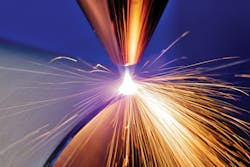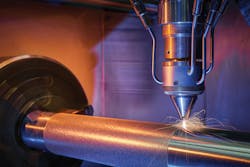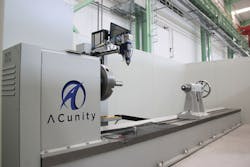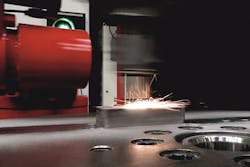Process yields increased speeds and lower costs over conventional methods
THOMAS SCHOPPHOVEN, ANDRES GASSER, and GERHARD BACKES
Engineers from the Fraunhofer Institute for Laser Technology (Fraunhofer ILT) and RWTH Aachen University (both in Aachen, Germany) have developed a novel extreme high-speed laser material deposition process that has been awarded three prestigious prizes (FIGURE 1). Under the German acronym EHLA, this process is not only conquering the coating market, but is also accelerating metallic 3D printing.
FIGURE 1. Laser material deposition is shown in action. (Copyright: Fraunhofer ILT, Aachen, Germany)
The recipe sounds simple: Take a laser, create a melt pool on the component’s surface, inject metal powder particles into the melt pool, and create a firmly bonded and dense protective layer on a component. The process has been around for years—it is called laser material deposition. But because the deposited layers were too big and it was too slow, it could not be used for the coating of large surfaces in many applications. This has changed with an invention that is now solving major challenges for many companies from the coating industry.
Standard processes such as hard chrome plating, thermal spraying, laser material deposition, and other deposition welding techniques have drawbacks. For example, since September 2017, coatings based on chromium (VI) require a special authorization. This has led to a shift in thinking in surface technology. The new requirement predominantly affects manufacturers that use coatings to protect metal components exposed to heavy stress against corrosion and wear. They face the greatest challenge in marine applications, where the saline environment causes components to wear and corrode more quickly, resulting in unplanned downtime or the failure of entire facilities—for example, on offshore platforms.
Application in the offshore market
IHC Vremac Cylinders B.V. (Apeldoorn, Netherlands), a subsidiary of Royal IHC, a well-known Dutch marine technology company, develops and manufactures hydraulic cylinders, swivels, and piston accumulators. Measuring up to 20 m long, these parts have to cope with extremely tough conditions in excavators, offshore equipment, civil engineering, and heavy machinery.
The Dutch company reacted very early to the authorization requirement for chromium (VI) coatings instituted in September 2017. “In the past, we had our hydraulic components coated by third parties,” says Andres Veldman, manager of engineering at IHC Vremac Cylinders. “So, we had to look for new companies that could effectively apply ductile and harder coatings.” For applying ductile coatings, electrolytic techniques are a good choice, and for hard coatings, high-velocity oxygen fuel (HVOF) spraying is an option. But the experts in Apeldoorn also took a close look at laser processes.
However, initial testing in 2006 had shown that conventional laser material deposition was too expensive and too complicated. “But we were convinced that this technique was the future,” Veldman remembers. “In the end, it was in 2014 that Hornet Laser Cladding B.V. (Lexmond, Netherlands) put us in touch with Fraunhofer ILT and the ultrafast EHLA process.”
IHC Vremac Cylinders opted to go with Fraunhofer ILT’s extreme high-speed laser material deposition process, which won the Joseph von Fraunhofer Prize in 2017, came second in the Steel in Research and Development category of the German steel industry federation’s Steel Innovation Award in 2018, and won the very prestigious Berthold Leibinger Innovationspreis in 2018. During the patented EHLA process, the powder particles are melted by the laser while they are still above the melt pool.
Coatings up to 500 m/min
The fact that the particles no longer need to melt in the melt pool means the processing speed can be increased from 0.5 to 2.0 m/min to as fast as 500 m/min. EHLA also makes it possible to reduce the thickness of the coating—previously, it was not possible to produce coatings <500 µm thick at high deposition rates, but now, it can get them to be as thin as 25–250 µm. It also makes coatings smoother, with a surface roughness reduced to just one-tenth of what it typically was with conventional laser material deposition.
FIGURE 2. Thomas Schopphoven, head of the Productivity and System Technology Team in the Laser Material Deposition Group at Fraunhofer ILT.
“The advantage of coating rotationally symmetrical components using EHLA is that the necessary technology can be easily integrated into a lathe,” explains Thomas Schopphoven, who heads the Productivity and System Technology team in the Laser Material Deposition group at Fraunhofer ILT in Aachen (FIGURE 2). In principle, only the laser beam source, EHLA processing head, and powder feed system need to be installed and connected to the control system (FIGURE 3).
FIGURE 3. The integration of a laser beam source, an EHLA processing head, and a powder feed system transforms a lathe into an extreme high-speed laser material deposition system. (Copyright: Fraunhofer ILT, Aachen, Germany/Volker Lannert)
The researchers in Aachen had initially installed the process on a small machine tool with which they could coat pipes at a speed of up to 3000 rpm. Their search for an equipment manufacturer ultimately led them to Hornet Laser Cladding, whose founders they had known for many years. Hornet was convinced of the technologies’ merits, and so the first EHLA system was built in 2014.
Certified technique successful in large-scale production
IHC Vremac Cylinders decided to take the plunge and have Hornet manufacture the first large-scale industrial EHLA system. The Dutch are now using the system in series production. After completing several projects, Veldman can state that EHLA currently costs about as much as thermal spraying. Since 2015, IHC Vremac Cylinders has coated several hundred hydraulic cylinders, at lengths of up to 10 m and diameters of up to 500 mm, with wear- and corrosion-resistant alloys to meet the most demanding offshore applications worldwide.
This fast, environmentally friendly technology is now also growing in popularity in China for the same reasons as in Europe. China plans to adopt the European model for regulating hard chromium plating. This is why, in 2017, the Fraunhofer ILT spinoff ACunity (also in Aachen) opted for a strategic collaboration with the China Academy of Machinery Science and Technology Group Co. Ltd. (CAM; Beijing, China) and delivered a 5-axis system with EHLA nozzle technology adapted by Fraunhofer ILT. Following the initial successful applications at CAM in Beijing, Hebei Jingye Additive Manufacturing Technology Co., Ltd. (Shijiazhuang City, China) ordered two systems for coating the exterior of offshore hydraulic cylinders measuring up to five meters in length with a maximum diameter of 1 m. The company also ordered another system for internal coatings (FIGURE 4).
FIGURE 4. Hebei Jingye Additive Manufacturing Technology has received three EHLA systems; here, the 5-m-long compact system for components weighing up to three metric tons is shown. (Copyright: ACunity)
The success of this brand-new technology hinges not only on systems technology, but also on process expertise and service. “Chinese companies place a great deal of emphasis on reliable processing, so we develop custom processes with the help of customer components,” says Chen Hong, managing director of ACunity. “We apply coatings to our customer’s components using the EHLA technique to check the quality of the processing in terms of protection against corrosion and wear. Of course, this also involves choosing or developing the right metal powder and fine-tuning the EHLA nozzle.”
Invented in Germany, tested and built in The Netherlands, and taking China by storm—is this invention destined to be a long-term success only abroad, and only in the ocean? That impression is deceptive: TRUMPF Laser- und Systemtechnik (Ditzingen, Germany) now offers laser systems in its TruLaser Cell range that include the EHLA technique for various component sizes.
Deposition in three dimensions
Another major application area for EHLA is the production of new parts using an innovative hybrid approach that combines conventional manufacturing methods—for example, casting or forging and additive manufacturing. They often involve subtractive processes: forged or cast blanks are frequently reworked with a great deal of effort, sometimes with 90% of the volume being machined, to arrive at the final component. The resource consumption as well as material and manufacturing costs are high.
FIGURE 5. Not only suitable for coating rotationally symmetrical components, the EHLA process is now being further developed for additive manufacturing of 3D geometries. (Copyright: Fraunhofer ILT, Aachen, Germany)
Until now, EHLA could only be used in rotationally symmetric parts. To utilize the advantages of EHLA also for the production of 3D geometries (FIGURE 5), a prototype system is currently being built in Aachen, where the workpiece is moved in a highly dynamic manner with up to fivefold gravitational acceleration under the EHLA powder nozzle.
THOMAS SCHOPPHOVEN([email protected]), ANDRES GASSER, and GERHARD BACKES are all with the Laser Material Deposition Group at the Fraunhofer Institute for Laser Technology (Fraunhofer ILT), Aachen, Germany; www.ilt.fraunhofer.de.





